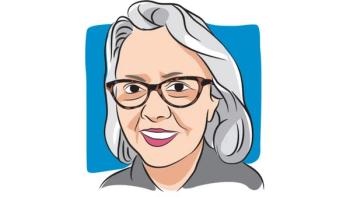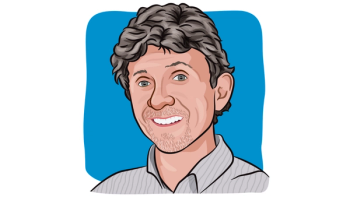
‘You Could Save a Life’: AML Survivor Reflects on Stem Cell Transplant

“Full-time mom, full-time hairdresser, full-time wife” Maggie Cambora, who received a diagnosis of acute myeloid leukemia in 2020, received a stem cell transplant.
The work that saved Maggie Cambora’s life began nearly 30 years before the Illinois mother, wife and hairdresser received a diagnosis of acute myeloid leukemia.
Cambora received a life-saving stem cell transplant in 2021 after being connected with a donor through the international nonprofit organization DKMS.
“Some people, when you talk to them about being a donor, they're like, ‘Oh, what do I have to do? Do I have to fast? Do I have to diet?’ I'm like, No, it's literally five minutes. (In) five minutes, you take three cheek swabs, you send it in, you see if you’re donor and then it's just a simple blood draw,” Cambora said. “You could save a life from a simple blood draw.”
“It is quite remarkable that in this day and age, there are still certain misconceptions surrounding this life-saving endeavor,” Katharina Harf, chairwoman of DKMS Global, toldCURE®. “A common misconception is that donation is invasive and painful. People seem to believe that it is a painful experience, when in reality, 90% of stem cells are collected via a procedure that is similar to a blood platelet donation.
Other misconceptions that persist around stem cell transplantation, Harf said, include the simplicity of the registration process, and the relative rarity of bone marrow donation — in approximately 10% of transplants, bone marrow is extracted from the back of the donor’s pelvic bone with a syringe.
“We work tirelessly to dispel these myths,” Harf said. “Through education and awareness campaigns, we make it clear that it is an extremely effective and relatively painless way to give people with blood cancer a second chance at life.”
Harf’s mother died of leukemia, and her father, Peter, partnered with his wife’s transplant doctor to found DKMS in 1991 with the goal of expanding the donor registry. Katharina and her father co-founded the first international branch of DKMS in 2004, and currently the organization reports that it operates in seven countries over five continents, with a network of more than 10 million registered donors.
Harf has a message for patients with cancer or their loved ones who are still waiting to be matched with a donor.
“I lost my mother to leukemia when I was just 14 years old, so I can relate to every family out there waiting for a potential lifesaver for their loved ones,” she said. “I understand the fear and uncertainty that comes with waiting for a matching donor, but I want to emphasize the importance of staying hopeful and resilient. Medicine has come a long way in the past 30 years, and please remember that there are dedicated individuals and organizations like DKMS working tirelessly to help you find a matching donor.
“My advice to you is to continue spreading awareness about the need for donors in your community. Every person you inform about the importance of being a donor brings us one step closer to finding a match. Don't hesitate to lean on the support of organizations like DKMS. They are there to assist you through this challenging journey, providing guidance and resources to support you. Stay strong, have faith and trust in the process. A matching donor can be found.”
A Survivor’s Story
In 2020, Cambora was 38 and, in her words, “a full-time mom, full-time hairdresser, full-time wife” living in northwest Illinois. “I was just living life to the fullest and enjoying life,” she said.
Then, in April 2020, during the early weeks of the COVID-19 pandemic, she started getting sick with flu-like symptoms, and lesions were appearing on her skin.
“I went to the dermatologist. They had no answers for me,” she said. “And so then I went to my PA, no answers, (my) GP, no answers. They did bloodwork (and) everything, nothing showed.”
By August, her health had continued to diminish; she was sleeping up to 20 hours a day and not eating or walking, she said.
“I couldn't get my daughter dressed. She was 3 at the time. And my husband was finally like, 'Just go to the hospital, go to a university hospital.' So I went to a Northwestern hospital nearby. And I went in — I don't remember going to the ER, I remember crawling across the parking lot — and they labeled me sepsis,” she said. “And the ER doctor who was there at the time, she took a blood draw, and she saw the blasts in my bone marrow and pretty much was 98% sure I had leukemia.”
Cambora was transferred to a different hospital via ambulance. Blood tests and a bone marrow biopsy led to a diagnosis of acute myeloid leukemia, and a rigorous chemotherapy regimen began that day. “I stayed downtown (in the hospital), without my children, without my husband, for a month,” she said.
Stem cell transplantation entered the conversation pretty much immediately, she said.
“I have no siblings, so they knew I would have to have a donor,” she said. “So, they started right away looking for a donor. I did three rounds of consolidation chemo, so I was there September for a week, October for a week, November for a week and none of those chemos helped diminish (the AML). And they still saw cancer cells in my blood.”
Chemotherapy with stem cell transplantation is one of the standard treatments for AML, as explained by the National Cancer Institute (NCI). Stem cell transplant, the NCI detailed on its website, replaces blood-forming cells which, alongside cancer cells, can be destroyed by high doses of chemotherapy.
A first attempted stem cell transplantation in January 2021 failed — “I’m not quite sure what happened, (it) could have been just not a match for me, my body rejected it,” she said — then a second potential donor fell through.
“And then a third one came through, my savior,” Cambora said. “And I had my second stem cell transplant on March 30, 2021, and then it took very quickly. I started improving, started seeing white blood cells, red blood cells, platelets (improve), that was amazing. And then I was able to come home April 26.”
Cambora’s eventual donor, Ronald Wardleigh, joined the DKMS donor pool during a donor drive at his alma mater, Western Colorado University, in 2017, and was contacted by DKMS to let him know he was a match for Cambora in April 2021. The pair and their families met in October 2022, an experience Cambora described as “like meeting a long lost family member, a long lost brother that I've never met. You know, I mean, he practically could be my brother, his DNA is so close to mine.”
And at DKMS, the work started decades ago to help patients such as Cambora continues via initiatives such as investments in advancing typing technology, conducting research and efforts to increase global access to transplantation, Harf said.
“My big dream is that every patient will be saved from blood cancer and other blood disorders,” she said. “When they get sick, we have a solution for them; whether it’s a donor, improving therapies through research or simply helping to provide access to transplantation. In this approach, we see no borders, believing that everyone, everywhere, deserves a second chance at life. We will keep fighting for them and keep spreading the word, recruiting donors, raising money, whatever it takes to make this dream a reality.”
For more news on cancer updates, research and education, don’t forget to





